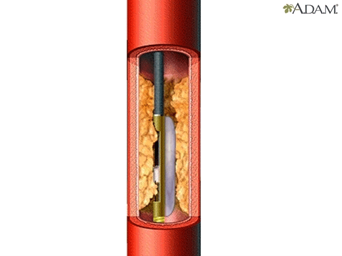What is Atherectomy Procedure?
Ather meaning fatty plaque. Ectomy meaning a surgical removal. This procedure removes fatty plaque from the arteries. This is a minimally-invasive vascular treatment that may be used for patients who are diagnosed with Peripheral Arterial Disease (PAD).
A laser atherectomy uses a catheter that emits pulses of ultraviolet light energy that are capable of gently vaporizing plaque and other matter into tiny microscopic particles that are smaller than a red blood cell.

Atherectomy vs Angioplasty
An angioplasty uses a special catheter with a balloon that can inflate to open blockages in the artery and then placing a stent to restore blood flow. An atherectomy uses a laser or a sharp blade to remove the plaque build up.
Benefits of Atherectomy in a vascular procedure?
It is a minimally invasive procedure and requires no hospital stay with a short recovery period. Other benefits include:
- Small incisions
- Less pain
- Low risk of infection
- Quick recovery time
- Less scarring
- Reduced blood loss
Risks of Endovascular Procedures
Catheter-Related Risks
Any procedure that involves placement of a catheter inside a blood vessel carries certain risks. These risks include damage to the blood vessel, bruising or bleeding at the puncture site, and infection. The chance of any of these events occurring is less than one percent.
Allergy to X-ray Contrast Material
Patients may have an allergic reaction to the x-ray contrast dye used during endovascular procedures. These episodes range from mild itching to severe reactions that can affect breathing or blood pressure. Patients having procedures are carefully monitored by a physician and a nurse during the procedure. In addition, if you have a contrast allergy we will pre treat you with special medicine to ensure that you do not have an allergic reaction.
X-ray exposure
Endovascular procedures are done under x-ray. Exposure levels are well below those where adverse effects on the patient would be a concern.
Potential Adverse Effects on the Kidneys
Patients with a history of poor kidney functions are at higher risk of further damage when xray dye is used. Blood work will be drawn to help identify patients at risk and levels will be monitored accordingly. IV fluids will also be given during and after the procedure to dilute the dye and filter the dye through the kidneys. In very rare cases additional medication may need to be given. For those patients with reduced kidney function, we have the ability to use carbon dioxide gas as a dye which is exhaled through the breath and has no effect on the kidneys. Your provider will speak with you about these options if it is necessary.
Medications to avoid
Any medications which you are taking will be reviewed with you prior to your procedure. Medicines such as blood thinners will be stopped 1-3 days prior according to which medicine you are taking. In addition some medicines taken or diabetes will need to be stopped or taken at a reduced dose prior to the procedure. Finally, blood pressure medicines will more than likely be continued the day of your procedure but some medicines that work by encouraging urination of excess fluid may be stopped. All medicine will be reviewed prior to procedure and you will be given written instructions before your procedure for what to take and what to stop temporarily.
What to Expect During Your Procedure
A local anesthetic numbs the skin in the groin area. A tube inserts into the artery as this is an excellent access point. This stage may be uncomfortable, but the discomfort is not severe.
You will be given medicine that will keep you comfortable during the procedure. While you may be awake you will be pleasantly sedated and we will work diligently to ensure your comfort. Our staff will communicate with you throughout the procedure to ensure you are comfortable and aware of everything that is occurring. We will even play your favorite type of music if you choose.
What to do After Your Procedure
Refrain from any heavy lifting (i.e. no more than 10 pounts), straining, pushing or impact exercises (i.e. running, jogging, cycling) for the first 7 days. You may walk, climb steps and even drive, so long as you do not have excessive bruising, swelling or pain at the puncture site(s).
You will be discharged with a dressing over the puncture site. This may be removed the next morning. Please inspect the puncture site daily for the first few days and notify us for any significant changes. Bruising around the area may be present. If you notice bleeding, swelling, or increase in bruising apply constant direct pressure over the area and seek medical attention IMMEDIATELY.
Refrain from soaking in a bathtub or hot-tub or pool until puncture is healed.
Resources
